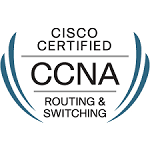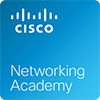CCNAv7.0 – интенсив
Станьте специалистом Cisco на наших курсах!
После прохождения нашего учебного курса Вы сможете с нуля построить компьютерную сеть, а также защитить эту сеть от большинства сетевых угроз. И разумеется подготовиться к новому тесту CCNA 200-301. Вы сможете устроиться на интересную и высокооплачиваемую работу в Украине или за рубежом.Группа | Курс | Форма обучения | Период обучения | Дни недели | Время занятий |
- Описание курса
- Программа курса

Курс CCNA - базовый курс по сетям и оборудованию Cisco. Интенсивное обучение позволяет пройти курс CCNA в сжатые сроки. В аудитории проводятся лекции и практика по настройке оборудования.
Требования к слушателям:знания на уровне курса "Networking Essentials"
Всем слушателям интенсивного курса CCNA доступ к курсу "Networking Essentials" предоставляется бесплатно.
Длительность курса:40ч.
Документ об окончании: международный сертификат Академии Cisco; международный сертификат CCNA по итогам тестирования.
Обучение на курсах CCNA начинается с регистрации на учебном портале netacad.com.
Учиться можно дистанционно - лекции слушать через вебинар, доступ к лабораторному железу удаленно по ssh. Записи лекций выкладываются. Обучение проводится сертифицированными инструкторами с практическим опытом работы. Лекции проводятся нормальным человеческим языком. Сложное станет простым и понятным.
По результатам внутреннего тестирования можно получить скидку на тест CCNA. Сдача CCNA происходит в любом из тестовых центров VUE
Перед сдачей CCNA в VUE рекомендуется пройти на учебном портале тест Practice CCNA. Этот тест полностью соответствует CCNA, но сдавать его можно бесплатно до 10 раз, что позволяет лучше подготовиться.
Записывайтесь на курс!
I. Introduction to Networks (ITN).
Module 1. Basic Switch and Device Configuration.
1.1. Cisco IOS Access
1.2. IOS Navigation
1.3. The Command Structure
1.4. Basic Device Configuration
1.5. Save Configurations
1.6. Ports and Addresses
1.7. Configure IP Addressing
1.8. Verify ConnectivityModule 2. IPv4 Addressing.
2.1. IPv4 Address Structure
2.2. IPv4 Unicast, Broadcast, and Multicast
2.3. Types of IPv4 Addresses
2.4. Network Segmentation
2.5. Subnet an IPv4 Network
2.6. Subnet a /16 and /8 Prefix
2.7. Subnet to Meet Requirements
2.8. Variable Length Subnet Masking
2.9. Structured DesignModule 3. Network Security Fundamentals.
3.1. Security Threats and Vulnerabilities
3.2. Network Attacks
3.3. Network Attack Mitigation
3.4. Device SecurityModule 4. Build a Small Network.
4.1. Devices in a Small Network
4.2. Small Network Applications and Protocols
4.3. Scale to Larger Networks
4.3. Verify Connectivity
4.4. Show Commands
4.5. Host and IOS Commands
4.6. Troubleshooting Methodologies
4.7. Troubleshooting ScenariosII. Switching, Routing and Wireless Essentials (SRWE)
Module 1. Basic Device Configuration.
1.1. Configure a Switch with Initial Settings
1.2. Configure Switch Ports
1.3. Secure Remote Access
1.4. Configure Basic Router Settings
1.5. Verify Directly Connected NetworksModule 2. Switching Concepts.
2.1. Frame Forwarding
2.2. Switching DomainsModule 3.VLANs.
3.1. Overview of VLANs
3.2. VLANs in a Multi-Switched Environment
3.3. VLAN Configuration
3.4. VLAN Trunks
3.5. Dynamic Trunking ProtocolModule 4, Inter-VLAN Routing.
4.1. Inter-VLAN Routing Operation
4.2. Configure Router-on-a-Stick Inter-VLAN Routing
4.3. Inter-VLAN Routing using Layer 3 Switches
4.4. Troubleshoot Inter-VLAN RoutingModule 5. STP.
5.1. Purpose of STP
5.2. STP Operations
5.3. Evolution of STPModule 6. EtherChannel.
6.1. EtherChannel Operation
6.2. Configure EtherChannel
6.3. Verify and Troubleshoot EtherChannelModule 7. DHCPv4.
7.1. DHCPv4 Operation
7.2. Configure DHCPv4 Server
7.3. Configure DHCPv4 ClientModule 8. FHRP Concepts.
8.1. First Hop Redundancy Protocol
8.2. HSRPModule 9. LAN Security Concepts.
9.1. Endpoint Security
9.2. Access Control
9.3. Layer 2 Security Threats
9.4. MAC Address Table Attack
9.5. LAN AttacksModule 10. Switch Security Configuration.
10.1. Implement Port Security
10.2. Mitigate VLAN Attacks
10.3. Mitigate DHCP Attacks
10.4. Mitigate ARP Attacks
10.5. Mitigate STP AttacksModule 11. Routing Concepts.
11.1. Path determination
11.2. Packet Forwarding
11.3. Basic Router Configuration review
11.4. IP Routing Table
11.5. Static and Dynamic RoutingModule 12. IP Static Routing.
12.1. Static Routes
12.2. Configure IP Static Routes
12.3. Configure IP Default Static Routes
12.4. Configure Floating Static Routes
12.5. Configure Static Host RoutesModule 13. Troubleshoot Static and Default Routes.
13.1. Packet Processing with Static Routes
13.2. Troubleshoot IPv4 Static and Default Route ConfigurationPart III. Enterprise Networking, Security, and Automation
Module 1. OSPFv2 Concepts.
1.1. OSPF Features and Characteristics
1.2. OSPF Packets
1.3. OSPF OperationModule2. Single-Area OSPFv2 Configuration.
2.1. OSPF Router ID
2.2. Point-to-Point OSPF Networks
2.3. Multiaccess OSPF Networks
2.4. Modify Single-Area OSPFv2
2.5. Default Route Propagation
2.6. Verify Single-Area OSPFv2Module 3. Multi-Area OSPF v2 Configuration.
3.1. Configure OSPFv2 Multi-Area
3.2. Stub Area configuration
3.3. Totally Stub Area configuration
3.4. Route summarization
3.5. Connecting RIP and OSPF networkModule 4. Network Security Concepts.
4.1. Current State of Cybersecurity
4.2. Threat Actors
4.3. Threat Actor Tools
4.4. Malware
4.5. Common Network Attacks
4.6. IP Vulnerabilities and Threats
4.7. TCP and UDP Vulnerabilities
4.8. IP Services
4.9. Network Security Best Practices
4.10. CryptographyModule 5. ACL Concepts.
5.1. Purpose of ACLs
5.2. Wildcard Masks in ACLs
5.3. Guidelines for ACL Creation
5.4. Types of IPv4 ACLs
5.5. Reflexive ACLsModule 6. ACLs for IPv4 Configuration.
6.1. Configure Standard IPv4 ACLs
6.2. Modify IPv4 ACLs
6.3. Secure VTY Ports with a Standard IPv4 ACL
6.4. Structure of an Extended IPv4 ACL
6.5. Configure Extended IPv4 ACLs
6.6. Configure Reflexive IPv4 ACLsModule 7. NAT for IPv4.
7.1. NAT Characteristics
7.2. Types of NAT
7.3. NAT Advantages
7.4. Configure Static NAT
7.5. Configure Dynamic NAT
7.6. Configure PAT
7.7. Port forwarding
7.8. NAT64Module 8. VPN and IPsec
8.1. VPN Technology
8.2. Types of VPNs
8.3. GRE Protocol
8.4. GRE configuration
8.5. IPsec
8.6. IPSec configuration
8.7. Encrypted IPSec/GRE tunnel configurationModule 9. Network Management
9.1. Device Discovery with CDP
9.2. Device Discovery with LLDP
9.3. NTP
9.4. SNMP
9.5. Syslog
9.6. Router and Switch File Maintenance
9.7. IOS Image Management

